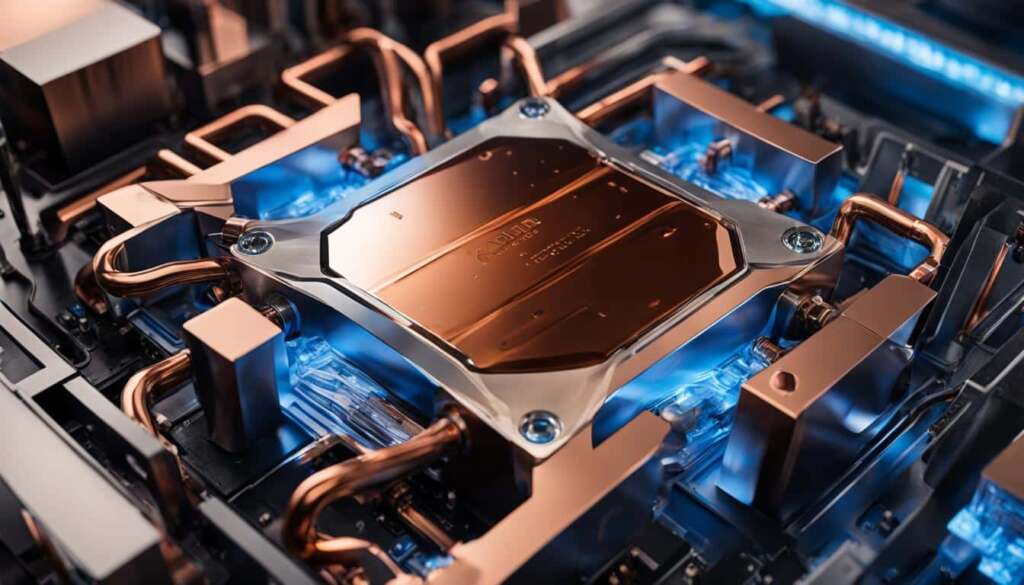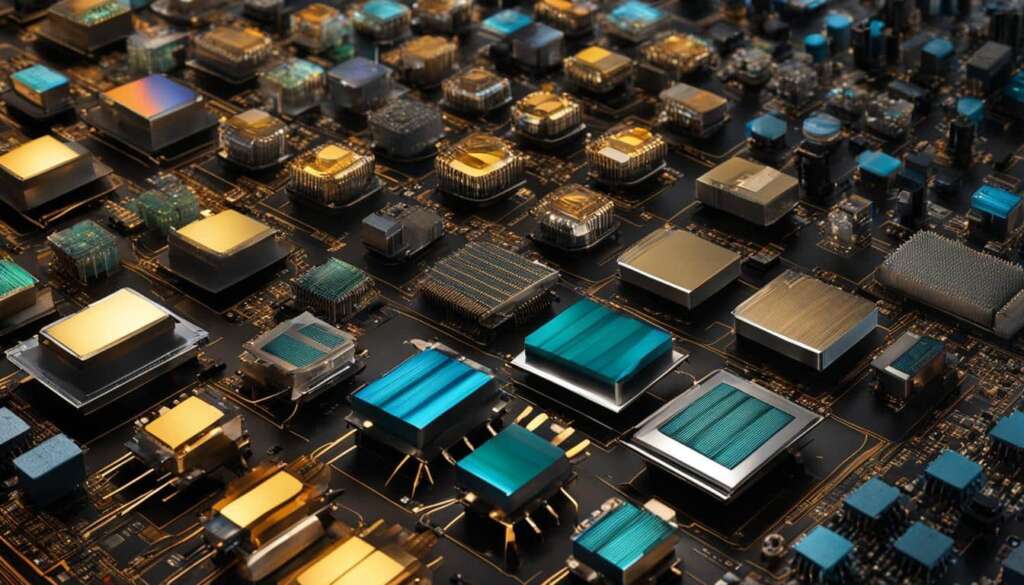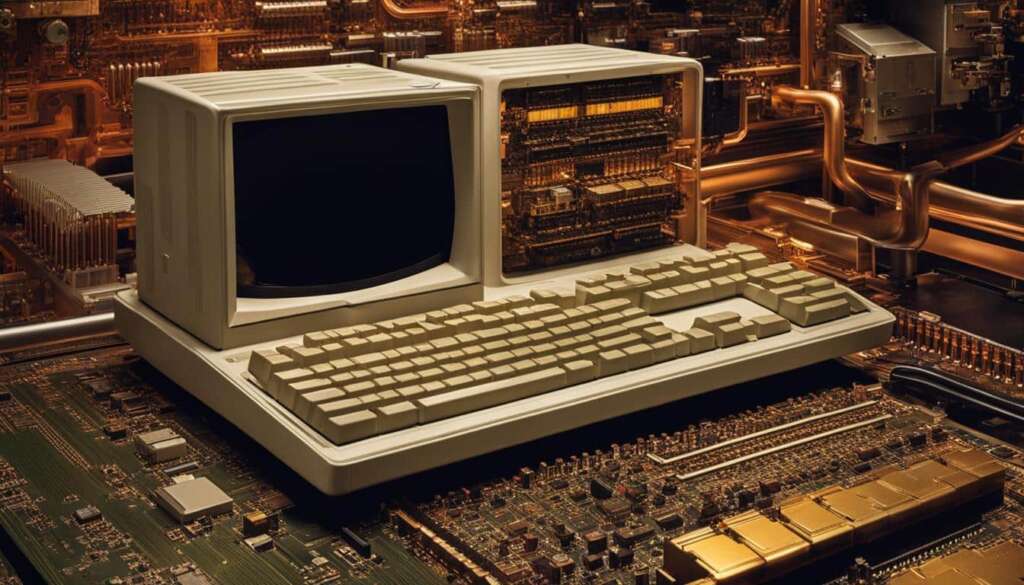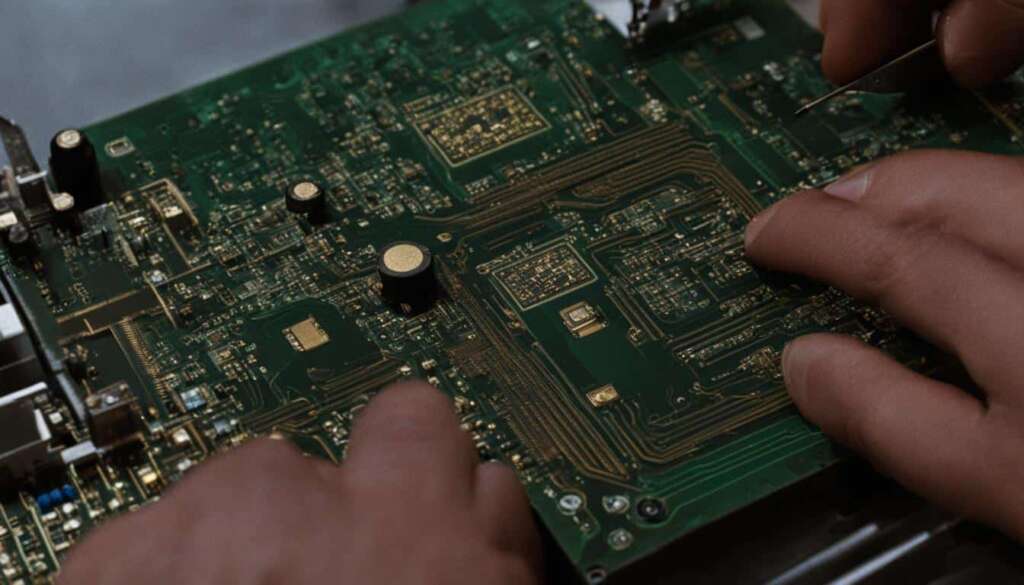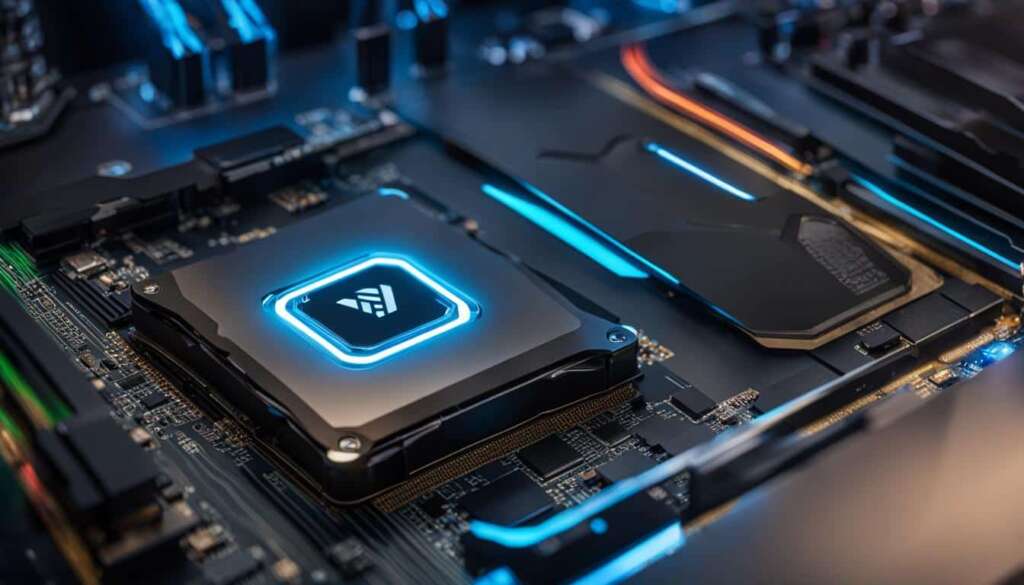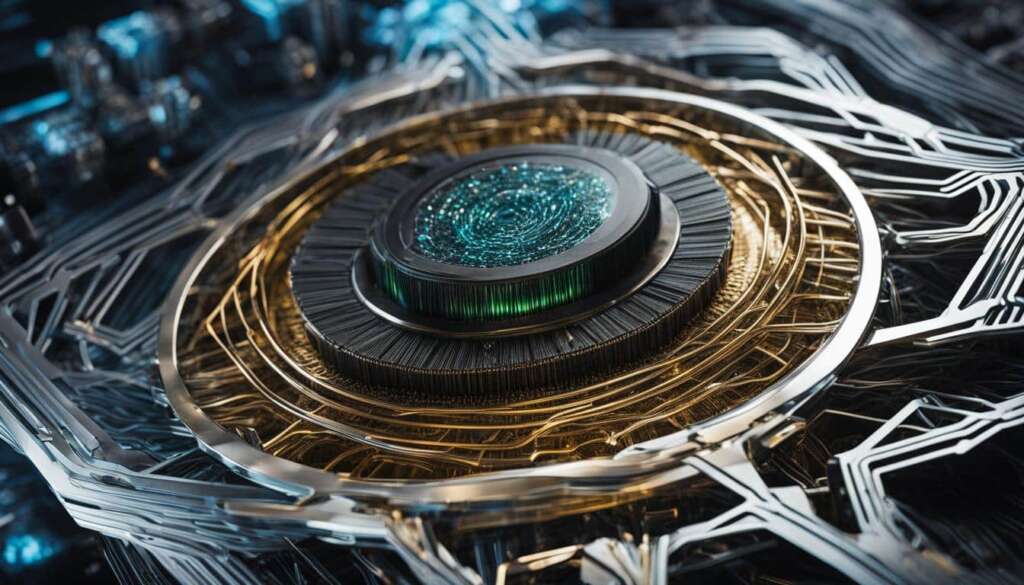Table of Contents
Overclocking CPUs has a long and fascinating history. It is the process of increasing the clock rate of a computer’s processor to exceed the speed certified by the manufacturer. This allows users to boost the performance of their PCs and achieve higher computing speeds. The concept of overclocking has evolved significantly over the years, from its introduction in the 1980s to the present day.
In the early days, overclocking was a complex process that required extensive knowledge, specialized hardware, and homemade cooling equipment. However, with advancements in technology and the development of user-friendly software, overclocking has become much easier and more accessible. Experienced overclockers can now achieve impressive results, pushing their CPUs to speeds of 8 GHz or more using methods like liquid nitrogen cooling and BIOS modding.
Overclocking has not only become a way to enhance PC performance but also a competitive sport. With events and competitions offering substantial prize pools, overclockers have the opportunity to showcase their skills and compete against each other in pushing the limits of processor performance.
The Beginning of Overclocking
The concept of overclocking began to emerge in the late 1980s and early 1990s when PCs operated at their default clock speeds, without user control over the system’s performance. However, with the introduction of overclockable motherboards, such as the i386 motherboards, users gained the ability to modify the CPU’s speed, voltage, and multiplier. These motherboards had minimal overclocking functionality, allowing users to choose from a few predetermined speeds and voltage settings. Although overclocking was not widely adopted initially due to limited knowledge and availability of aftermarket cooling solutions, it laid the foundation for future advancements in overclocking technology.
To understand the early days of overclocking, it is essential to recognize the significance of overclockable motherboards. These motherboards provided users with the ability to customize their system’s clock speeds and experiment with performance enhancements. While the overclocking capabilities were limited compared to today’s standards, it sparked the curiosity of computer enthusiasts and set the stage for further developments in the field. The introduction of overclockable motherboards opened the door to a world of possibilities, paving the way for future innovations in cooling solutions and more advanced overclocking techniques.
“Overclocking is a journey that starts with exploring the limitations of your hardware and ends with the satisfaction of achieving higher performance levels than what was originally thought possible.” – Anonymous overclocking enthusiast
As overclocking gained traction, the demand for more user-friendly solutions grew. Computer hardware vendors responded by developing cooling solutions specifically designed for overclocking, such as water-cooling kits. These kits offered better heat dissipation, allowing users to push their components to higher speeds while maintaining stable operating temperatures. The availability of these cooling solutions, coupled with the rise of extreme cooling methods like liquid nitrogen and dry ice, brought overclocking into the mainstream and attracted a growing community of overclocking enthusiasts.
| Year | Milestone |
|---|---|
| Late 1980s – Early 1990s | Introduction of overclockable motherboards, allowing users to modify CPU clock speeds |
| Late 1990s – Early 2000s | Development of user-friendly cooling solutions and rise of extreme cooling methods |
| 2006 – 2010 | Overclocking becomes a popular hobby and e-sport with the support of hardware vendors and media coverage |
When Overclocking Got Easier
In the late 1990s and early 2000s, overclocking became more user-friendly and widespread. Hardware vendors started releasing cooling solutions specifically designed for overclocking, such as water-cooling kits. These kits were more efficient at dissipating heat and allowed users to push their components to higher speeds. This period also saw the rise of extreme cooling methods like liquid nitrogen and dry ice, which became popular among overclockers.
Moreover, overclocking competitions and events gained momentum, attracting media attention and increasing public interest in overclocking. The combination of improved cooling solutions, media coverage, and enthusiast participation contributed to the rapid growth of overclocking during this time.
To showcase the impact of user-friendly overclocking and extreme cooling methods, the table below highlights some notable achievements in overclocking competitions:
| Year | Overclocker | CPU | Clock Speed (GHz) | Event |
|---|---|---|---|---|
| 2001 | Timothée Loubrieu | Intel Pentium 4 | 4.13 | World Cyber Games |
| 2003 | Kinc | Intel Pentium 4 | 5.22 | Team Finland OC Challenge |
| 2007 | Coolaler | Intel Core 2 Duo | 8.0 | Overclocking World Cup |
These achievements demonstrate the incredible potential of overclocking when combined with innovative cooling methods and competitive events. They also reflect the growing enthusiasm and skill of overclockers worldwide.
Overclocking Explodes in Popularity
Between 2006 and 2010, overclocking gained immense popularity among enthusiasts and became a recognized e-sport. The availability of overclocking-friendly motherboards and the support from vendors like ASUS and Intel were crucial factors in the rapid growth of overclocking competitions. These events attracted participants from all over the world and offered substantial prize pools, creating excitement and fostering a competitive spirit within the overclocking community.
The media played a significant role in promoting overclocking as well. Coverage of overclocking events and competitions showcased the incredible achievements of overclockers, captivating the attention of PC hardware and gaming enthusiasts. Magazine articles and online features highlighted the remarkable capabilities of overclocked systems, inspiring a broader audience to delve into the world of overclocking and push their hardware to its limits.
“Overclocking competitions received extensive coverage, showcasing the achievements of overclockers and highlighting the capabilities of overclocked systems.”
Overclocking also witnessed a surge in media coverage during this time. Magazines, internet news websites, and online communities provided platforms for overclocking enthusiasts to share their experiences, knowledge, and achievements. The media attention surrounding overclocking events and competitions, along with the enthusiastic engagement of the community, contributed to the exponential growth of overclocking’s popularity and recognition as a legitimate pursuit.
| Year | Overclocking Event | Prize Pool |
|---|---|---|
| 2006 | ASUS Overclocking Challenge | £50,000 |
| 2007 | Intel Extreme Masters Overclocking | €100,000 |
| 2008 | World Series of Overclocking | $150,000 |
| 2009 | Overclocking World Championship | $250,000 |
| 2010 | MSI Master Overclocking Arena | €300,000 |
The Impact of Advancements in Cooling Technology
The evolution of cooling technology has played a pivotal role in the development and growth of processor overclocking. As CPUs and GPUs have become more powerful, the need for efficient heat dissipation has become paramount to prevent overheating and maintain system stability.
Extreme cooling methods, such as liquid nitrogen, have emerged as popular choices among overclocking enthusiasts. By keeping temperatures extremely low, these methods allow for even higher clock speeds and greater performance. The use of liquid nitrogen cooling has become synonymous with extreme overclocking, pushing the boundaries of what is possible in terms of achieving higher clock speeds.
“Liquid nitrogen is a game-changer when it comes to overclocking. It allows us to achieve clock speeds that were once unimaginable. With the right hardware and precautions, we can push our systems to their limits and achieve impressive performance gains.” – Overclocking Enthusiast
In addition to extreme cooling methods, advancements in air-cooling heat sinks have also contributed to the accessibility of overclocking. Improved heat dissipation capabilities have made it easier for a wider range of users to engage in overclocking without the need for complex cooling setups.
| Advancements in Cooling Technology | Benefits |
|---|---|
| Liquid Nitrogen | – Allows for even higher clock speeds – Enables extreme overclocking |
| Air-Cooling Heat Sinks | – Improved heat dissipation – Increased accessibility for overclockers |
Overall, the impact of advancements in cooling technology cannot be overstated. It has pushed the boundaries of overclocking, enabling enthusiasts to achieve higher clock speeds and unleash the full potential of their processors. As cooling technology continues to evolve, we can expect even greater opportunities for overclocking and the pursuit of unmatched computing performance.
The Role of Media in Promoting Overclocking
Media coverage has played a significant role in promoting and popularizing overclocking. Overclocking events and competitions have received extensive coverage, showcasing the achievements of overclockers and highlighting the capabilities of overclocked systems. Magazines, internet news websites, and online communities have provided a platform for enthusiasts to share their experiences and knowledge, contributing to the growth of overclocking as a hobby and competitive pursuit. The media attention surrounding overclocking events and the incredible feats achieved by overclockers have attracted mainstream attention and fueled the enthusiasm of PC hardware and gaming enthusiasts.
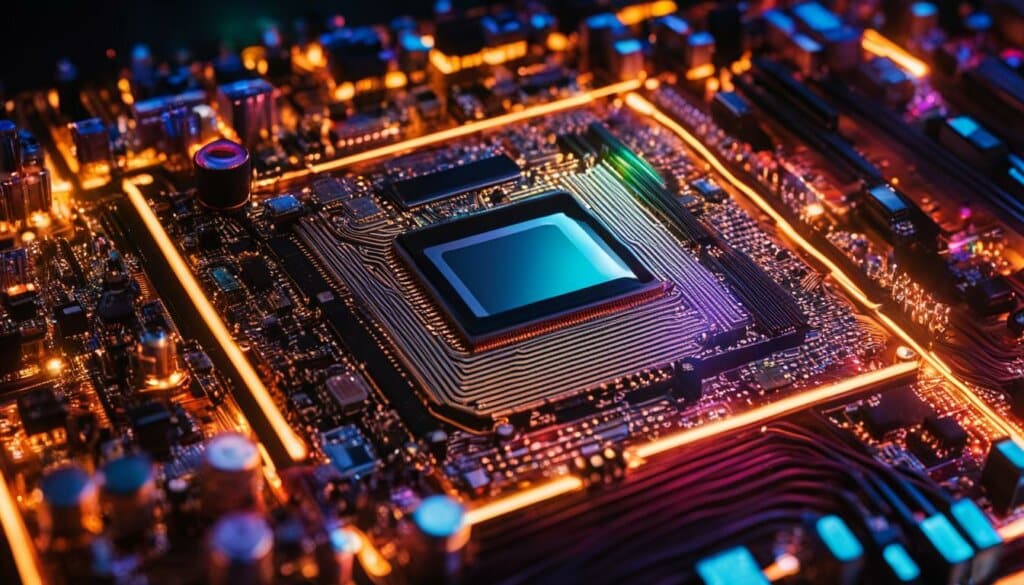
Overclocking events have become a spectacle, drawing in large crowds and garnering significant media coverage. These events often feature top overclockers competing against each other to achieve record-breaking clock speeds and benchmark scores. Media outlets cover these events, reporting on the winners, the hardware used, and the techniques employed to achieve impressive results.
The media coverage not only promotes overclocking as a competitive pursuit but also highlights it as a form of art and craftsmanship. Enthusiasts are able to showcase their creativity and technical skills through the customization of cooling solutions, modification of BIOS settings, and fine-tuning of system components. This aspect of overclocking has inspired and attracted a dedicated community of enthusiasts, fostering an overclocking culture where knowledge sharing and innovation thrive.
Overclocking as a Tool for Performance Enhancement
Overclocking is a powerful technique that allows users to boost the performance of their processors and achieve improved computing speeds. By increasing the clock speed of the CPU beyond its factory-set limits, users can unlock the full potential of their systems and enjoy a significant performance boost. Faster clock speeds result in improved system responsiveness, faster task execution, and enhanced overall computing speed.
Overclocking is particularly beneficial for resource-intensive tasks such as gaming, video editing, and 3D rendering. These tasks require high computing power, and overclocking provides the means to achieve the desired performance levels. By pushing the CPU to higher clock speeds, users can ensure smoother gameplay, faster video rendering, and quicker 3D model rendering, thereby enhancing the user experience.
The Impact of Clock Speed on Performance
The clock speed of a processor directly affects its performance. The CPU executes instructions at each clock cycle, and a higher clock speed means more instructions can be executed per second. This translates to faster processing of tasks and improved overall system performance. However, it’s important to note that increasing the clock speed also leads to increased power consumption and heat generation, which must be managed carefully to maintain system stability.
When overclocking, it is crucial to have a reliable cooling solution to dissipate the additional heat generated. Adequate cooling ensures that the system remains stable and prevents overheating, which can lead to performance degradation and potential hardware damage. Users should also gradually increase the clock speed to find the optimal balance between performance and stability, monitoring temperature levels and ensuring a stable power supply to handle the increased power consumption.
| Benefits of Overclocking | Considerations |
|---|---|
| Improved computing speed | Risks of increased power consumption and heat generation |
| Enhanced system responsiveness | The need for adequate cooling solutions |
| Faster task execution | The importance of gradual overclocking |
| Optimized performance for resource-intensive tasks | Monitoring temperature levels |
The Future of Overclocking
As advancements in technology continue to accelerate, the future of overclocking holds great promise. Manufacturers are constantly improving the design of CPUs and motherboards to provide better overclocking potential and opportunities for enthusiasts. The overclocking potential of processors is expected to increase, allowing users to achieve even higher clock speeds and enhanced computing performance.
One area of advancement in overclocking technology is cooling solutions. Cooling solutions play a vital role in maintaining system stability and preventing overheating. With the development of more efficient cooling techniques, such as advanced liquid cooling systems, overclockers will have improved options for managing heat dissipation and pushing their processors to new limits.
Advancements in software tools and utilities have also made overclocking more accessible to novice users. User-friendly software interfaces and automated overclocking features help simplify the process and reduce the risks associated with manual overclocking. These advancements empower a broader range of users to explore the benefits of overclocking without requiring extensive technical knowledge.
The overclocking community will continue to drive innovation and competition. Overclocking events and competitions will serve as platforms for enthusiasts to showcase their skills and push the boundaries of what is achievable. These events will attract media attention, further promoting the hobby and advancing the overclocking culture.
| Advancements in Overclocking Technology | Overclocking Potential |
|---|---|
| Improved CPU and motherboard design | The potential for higher clock speeds |
| Advanced cooling solutions | Enhanced heat dissipation and temperature management |
| User-friendly software tools | Accessible overclocking for novice users |
| Competitive overclocking events | Advancement of overclocking culture |
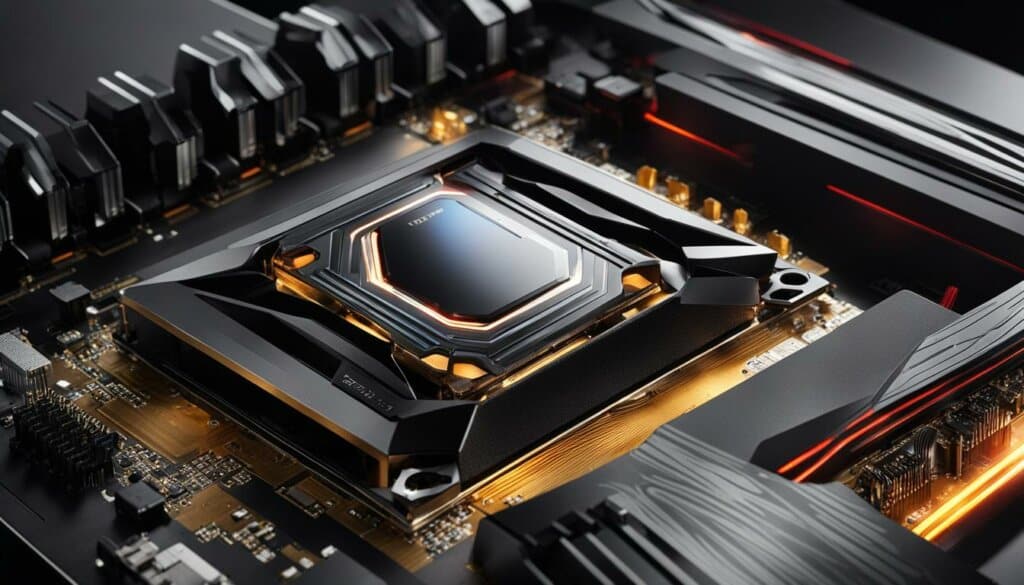
Advancements in CPU and Motherboard Design
Manufacturers are continuously improving the design of CPUs and motherboards to provide better overclocking potential. This includes optimizing power delivery systems, improving thermal management, and enhancing overall stability. With each new generation of processors and motherboards, overclockers can expect improved performance and higher clock speeds.
Advanced Cooling Solutions
Cooling plays a critical role in overclocking, and advancements in cooling solutions have been a significant driving force behind overclocking progression. Advanced liquid cooling systems, combined with efficient heat sinks and fans, allow overclockers to push their processors to new limits while maintaining stable temperatures. These cooling solutions are expected to become more accessible and efficient, enabling even higher clock speeds in the future.
User-Friendly Software Tools
Software tools and utilities have made significant advancements, making overclocking more accessible to novice users. User-friendly interfaces and automated overclocking features simplify the process and reduce the risks associated with manual overclocking. Novice overclockers can now achieve impressive results without the need for extensive technical knowledge, expanding the reach and impact of overclocking.
Competitive Overclocking Events
Overclocking events and competitions continue to drive innovation and foster the overclocking culture. These events bring together enthusiasts from around the world to showcase their skills, compete for recognition, and push the boundaries of what is achievable. The competitive nature of these events fuels advancements in overclocking technology and attracts media attention, further increasing the popularity and growth of overclocking.
Safe Practices for Processor Overclocking
When it comes to processor overclocking, it is essential to follow safe practices to ensure both performance enhancement and system stability. Overclocking can offer significant benefits in terms of improved computing speed, but it also carries certain risks that need to be managed effectively.
One important aspect of safe overclocking is the use of reliable cooling solutions to dissipate heat generated by the increased clock speeds. Efficient cooling is essential to prevent overheating and maintain system stability. It is recommended to invest in high-quality cooling systems such as liquid cooling or advanced air cooling solutions that can handle the increased heat output.
Monitoring temperature levels is also crucial during overclocking to avoid exceeding safe operating limits. Overheating can lead to system instability and potentially cause permanent damage to the processor. Utilizing software tools or BIOS settings that provide real-time temperature monitoring can help ensure that the system remains within safe temperature ranges.
“Proper cooling is crucial for safe overclocking. Without adequate cooling, the increased heat generated by overclocking can lead to system crashes, instability, and even irreversible damage to the processor.”
Another important practice is to gradually increase clock speeds and test the system’s stability at each step. This allows for finding the optimal balance between performance and stability. Incrementally raising clock speeds and stress testing the system using benchmarking tools helps identify any stability issues that may arise. If stability problems occur, it is recommended to dial back the overclock or adjust other settings to ensure a stable system.
Table: Safe Practices for Processor Overclocking
| Safe Practices | Description |
|---|---|
| Use reliable cooling solutions | Invest in high-quality cooling systems to dissipate heat effectively and prevent overheating. |
| Monitor temperature levels | Utilize software tools or BIOS settings to monitor CPU temperature and prevent overheating. |
| Gradually increase clock speeds | Incrementally raise clock speeds and test system stability at each step to find the optimal balance. |
| Stress test the system | Use benchmarking tools to stress test the system and identify any stability issues that may arise. |
| Ensure stable power supply | Use a stable power supply and ensure that it can handle the increased power consumption associated with overclocking. |
By following these safe practices, users can enjoy the benefits of processor overclocking while minimizing the risks. Safe overclocking can lead to improved performance and enhanced computing speed, providing an optimized experience for resource-intensive tasks such as gaming, video editing, and 3D rendering. However, it is essential to remember that every system is different, and individual results may vary. Users should always proceed with caution, thoroughly research their specific hardware components, and consult manufacturer guidelines and resources to ensure safe and successful overclocking.
Best Processors for Overclocking
When it comes to overclocking, having the right processor can make all the difference. Some processors are known for their overclocking potential, offering high clock speeds and robust power delivery systems. These processors are designed with overclocking in mind, providing users with the tools they need to push their systems to the limit.
Here are some of the best processors for overclocking:
- Intel Core i9 series: The Intel Core i9 series processors are renowned for their exceptional performance and overclocking capabilities. With unlocked multipliers and robust power delivery, these processors can handle high clock speeds with ease, allowing users to squeeze every bit of performance out of their systems.
- AMD Ryzen series: The AMD Ryzen series processors have gained a reputation for their impressive overclocking potential. With unlocked multipliers and a range of processors to choose from, including the Ryzen 9 and Ryzen 7 models, users have plenty of options for achieving high clock speeds and improved computing performance.
- Intel K-series processors: The Intel K-series processors, such as the Intel Core i7 and Core i5 models, are designed for overclocking enthusiasts. These processors feature unlocked multipliers and robust power delivery systems, making them ideal for achieving high clock speeds and pushing the limits of performance.
When overclocking, it is important to choose a processor that offers the right balance of performance and stability. These processors have been tested and proven to deliver exceptional overclocking performance, making them the top choices for enthusiasts and power users.
Keep in mind that overclocking carries certain risks, such as increased power consumption and heat generation. It is essential to follow safe practices and ensure proper cooling to maintain system stability and longevity. With the right processor and proper precautions, users can unlock the full potential of their systems and enjoy improved computing speeds.
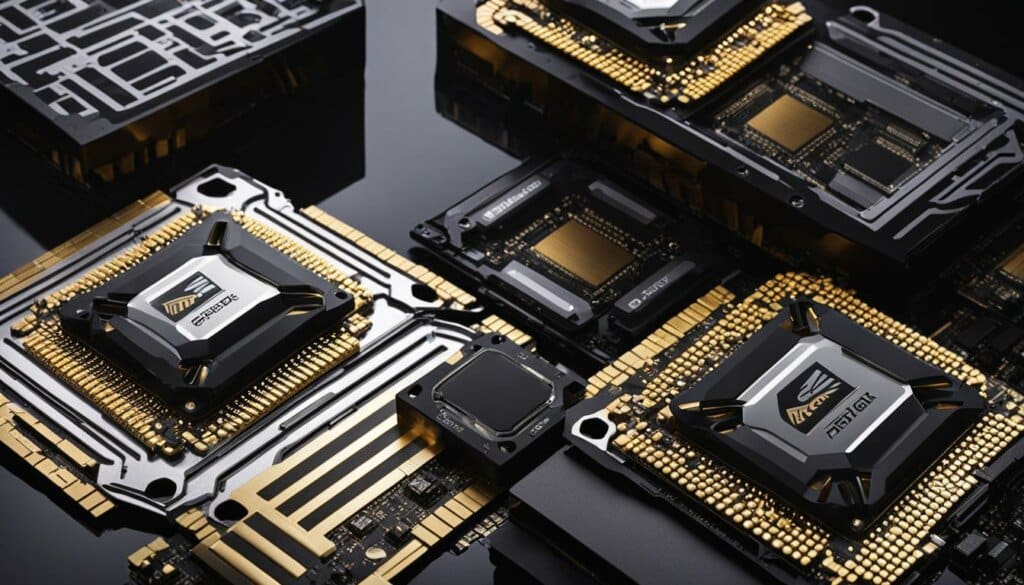
Conclusion
Processor overclocking offers a range of benefits, allowing users to unlock the full potential of their CPUs and achieve higher clock speeds. By increasing the processor’s clock rate, users can enjoy improved computing performance and faster task execution. Overclocking is particularly advantageous for resource-intensive tasks like gaming, video editing, and 3D rendering, where higher clock speeds can significantly enhance the user experience.
With advancements in cooling technology, hardware design, and software tools, overclocking has become more accessible than ever before. Enthusiasts can now take advantage of user-friendly overclocking software to easily adjust clock speeds and achieve optimal performance. However, it is crucial to approach overclocking with caution and follow safe practices. This includes using reliable cooling solutions to dissipate heat effectively, monitoring temperature levels to prevent overheating, and gradually increasing clock speeds to maintain stability and avoid potential risks.
Whether you’re a seasoned overclocker or new to the world of CPU tweaking, a comprehensive overclocking guide can provide valuable insights and instructions on how to safely and effectively overclock your processor. Additionally, there is a wide range of overclocking software available that can assist in monitoring and fine-tuning your system for optimal performance. By following best practices and utilizing the right tools, you can enjoy the benefits of processor overclocking and enhance your computing experience.
FAQ
What is overclocking?
Overclocking is the process of increasing the clock rate of a computer’s processor to exceed the speed certified by the manufacturer.
How does overclocking boost PC performance?
By pushing the CPU beyond its factory-set limits, users can achieve higher computing speeds, resulting in improved system responsiveness and faster task execution.
Is overclocking beneficial for gaming?
Yes, overclocking can significantly enhance the gaming experience by providing faster computing speeds.
Are there any risks associated with overclocking?
Yes, overclocking can increase power consumption and heat generation, which must be managed carefully to ensure system stability and longevity.
What are the best processors for overclocking?
Processors such as the Intel Core i9 series, AMD Ryzen series, and Intel K-series processors are known for their overclocking potential.
How has cooling technology advanced overclocking?
Advancements in cooling technology, such as liquid nitrogen and improved air-cooling heat sinks, have allowed for higher clock speeds and better heat dissipation.
How has the media promoted overclocking?
Media coverage of overclocking events and competitions has showcased the achievements of overclockers and increased public interest in overclocking as a hobby and competitive pursuit.
What does the future hold for overclocking?
Advancements in technology and hardware design will continue to push the boundaries of what is achievable in overclocking, providing even higher clock speeds and improved performance.
What are some safe practices for processor overclocking?
It is important to use reliable cooling solutions, monitor temperature levels, and gradually increase clock speeds to maintain system stability and prevent overheating.
How can I ensure safe overclocking?
By following best practices, such as maintaining a stable power supply and carefully managing heat dissipation, users can enjoy the benefits of overclocking while minimizing risks.


